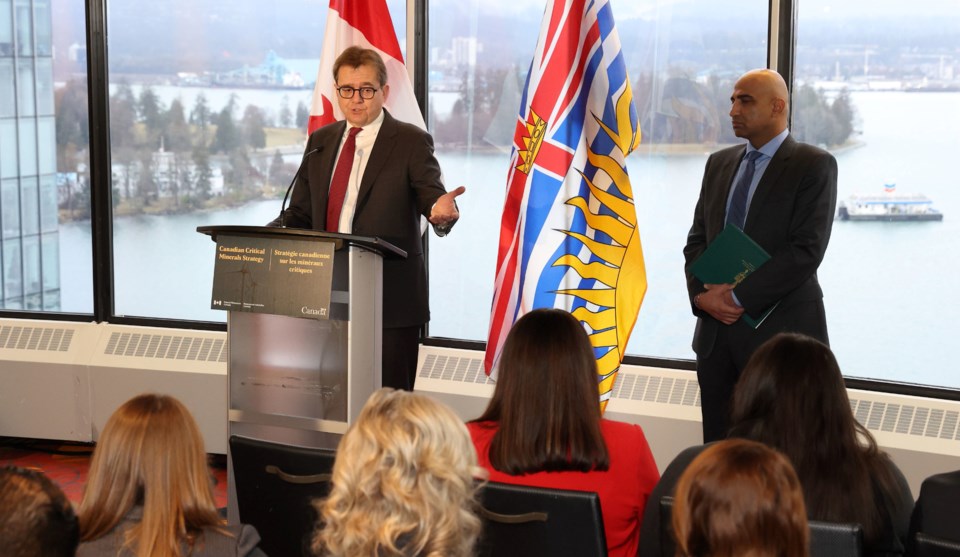Federal Natural Resources Minister Jonathan Wilkinson said Ottawa and the provinces must work together to expedite the regulatory and permitting processes that bring new mines into production in a timely way.
But federal approvals for this industrial developments won’t be granted at the expense of cutting corners from an environmental perspective and in a manner that disrespects the rights of Indigenous people and communities.
Wilkinson was in Vancouver Dec. 9 reiterating his government’s previously announced critical minerals strategy and the available $3.8 billion in federal funding for initiatives and projects related to exploration, minerals processing, manufacturing and recycling.
With U.S. and international electric vehicle and clean energy companies desperately wanting access to Canada’s abundant resources of nickel, lithium and other critical minerals in order to make the transition to the net-zero emission economies, Wilkinson said waiting an average of 12 years for government to approve new mines in Canada just won’t cut it.
Wilkinson, who talked extensively about finding ways to speed up and bring efficiencies to environmental assessment and permitting processes, said the pathway to bring mines into production will be done in an environmentally sustainable way that involves meaningful Indigenous partnerships.
When asked by reporters about the future of the Ring of Fire in Ontario’s Far North, a potential high-grade mining camp that’s been mired in government bureaucracy since the discovery of chromite and nickel 15 years ago, Wilkinson called the mineral-rich James Bay region a “particularly challenging space.”
Much of the natural environment is covered by vast peatlands, considered a global carbon sink, and “several” Indigenous communities in the region have raised questions and concerns about industrial development, he said.
“Both of those issues have to be addressed in any agreement that mining in the Ring of Fire is going to proceed,” Wilkinson said.
And those conversations are taking place with the communities, the Ontario government, and the mining companies, he said.
With the feds recently approving a major environmental permit for an open-pit palladium near Marathon, Wilkinson mentioned there are many mining projects in Ontario and across Canada that are further down the path to production than anything that’s been tabled for the Ring of Fire.
Despite many years of intensive exploration efforts in Ontario’s Far North and many millions of dollars invested, Wilkinson said his department has yet to see a formal mine project proposal for the Ring of Fire, “so it ‘s not the best example on how you expedite these things.”
But the region’s open-ended mineral potential has captured widespread attention and attracted Australia's Wyloo Metals to acquire Toronto’s Noront Resources (since renamed Ring of Fire Metals) and its extensive nickel and base metals package last year.
Though acknowledging Canada’s inherent mineral advantage to create secure and reliant supply chains for manufacturers, Wilkinson emphasized Ottawa is taking a pro-environmental stance on resource development, and one that is supportive of Indigenous people’s rights.
“There may be pathways through which you protect the areas that are peat - and you protect those ideally on a permanent basis - and you find spaces where you actually can do mining in a manner that actually is environmentally sensitive.”
Ultimately, he said, there has to be engagement and discussion to reach an agreement that satisfies Indigenous people.
“I certainly wouldn’t rule it (the Ring of Fire) off the table – I think it’s very interesting from a mineral deposit perspective – but it has to be done through considering some of these legitimate issues, including the peat.”
The proposed road to the Ring of Fire still remains in the detailed engineering and environmental assessment stages, led by Marten Falls and Webequie First Nations, two supportive communities that stand to benefit from permanent overland access to the provincial highway system.
But due to concerns about Far North industrial development by outlying First Nations, Wilkinson called for a Regional Assessment process for the Ring of Fire in February 2020, when he was the federal environment minister. However, the process continues to lag. It has yet to officially begin since his ministerial successor, Steven Guilbeault, has not signed off on the terms of reference.
Wilkinson defended the process, calling the Regional Assessment a “tool” that Ottawa can use where there are regional concerns about the negative cumulative impact about industrial development. And it can also be a process that could actually help expedite an individual mine project environmental assessment process.
In promoting better regulatory cooperation and streamlining processes between governments, Wilkinson is setting up Regional Energy and Resources Tables. Individual tables have been established in nine provinces and territories, including Ontario.
As well, there are lessons and best practices that Canada can learn from and adopt from other countries provided it’s done “in the right way.”
“I think there’s a lot we can do.”
